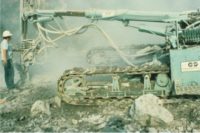NIOSH reviews cancer, REL policy

 The National Institute for Occupational Safety and Health has initiated a review of its method of classifying carcinogens and establishing recommended exposure limits (RELs) for occupational exposures to hazards associated with cancer. As part of the review, NIOSH is requesting input from interested parties.
The National Institute for Occupational Safety and Health has initiated a review of its method of classifying carcinogens and establishing recommended exposure limits (RELs) for occupational exposures to hazards associated with cancer. As part of the review, NIOSH is requesting input from interested parties.
A statement from NIOSH said the move was prompted by concerns expressed recently by stakeholders.
“A major limitation in the policy is the use of the term ‘Potential Occupational Carcinogen,’ which dates to the 1980 OSHA hazard classification for carcinogens outlined in 29 CFR 1990.103 and is defined as ‘any substance, or combination or mixture of substances, which causes an increased incidence of benign and/or
malignant neoplasms, or a substantial decrease in the latency period between exposure and onset of neoplasms in humans or in one or more experimental mammalian species as the result of any oral, respiratory or dermal exposure, or any other exposure which results in the induction of tumors at a site other than the site of administration. This definition also includes any substance which is metabolized into one or more potential occupational carcinogens by mammals.’
A major limitation of this definition is that the policy allows for only one cancer category, which is ‘potential occupational carcinogen.’ The adjective potential conveys uncertainty that is not warranted with many carcinogens such as asbestos, benzene, and others. This policy does not allow for classification on the basis of the magnitude and sufficiency of the scientific evidence. In contrast, other organizations, such as the International Agency for Research on Cancer (IARC) and the National Toxicology Program (NTP) allow for a more differential classification.
The revision of the policy “also coincides with the international realization that there is a need for more efficient and quicker means of classifying chemicals,” according to NIOSH. “Qualitative and semi-quantitative approaches such as hazard banding are increasingly being investigated as a means of addressing the vast numbers of unregulated chemicals.”
NIOSH has been working with various organizations on utilizing hazard banding approaches to control chemicals.
A report from NIOSH on its revised Carcinogen and REL policies is expected to be available in the spring of 2012.
All input should refer to docket number NIOSH-240 and submitted by September 22, 2011. Written comments may be mailed to: NIOSH Docket Office/Robert A. Taft Laboratories/MS-C34/4676 Columbia Parkway/Cincinnati, Ohio 45226, faxed to: (513) 533-8285 or emailed to: nioshdocket@cdc.gov.
All information received will be available for public examination and copying at the NIOSH Docket Office, 4676 Columbia Parkway, Room 111, Cincinnati, Ohio 45226. A complete electronic docket containing all comments submitted will be available on the NIOSH Web page at http://www.cdc.gov/niosh/docket.
NIOSH has also created a new NIOSH Cancer and REL Policy Web Topic Page (http://www.cdc.gov/niosh/topics/cancer/policy.html) to provide additional details about this effort and progress updates.
Looking for a reprint of this article?
From high-res PDFs to custom plaques, order your copy today!




